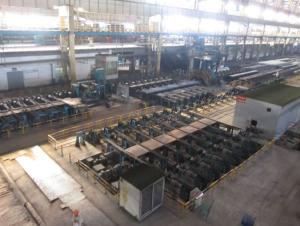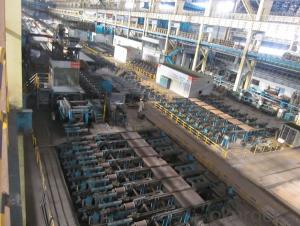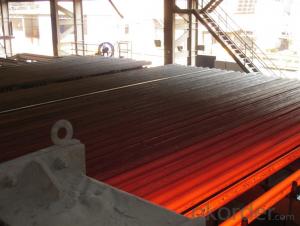Prime quality square alloy steel billet 90mm Q235
- Loading Port:
- Tianjin
- Payment Terms:
- TT OR LC
- Min Order Qty:
- 100 m.t.
- Supply Capability:
- 10000 m.t./month
OKorder Service Pledge
OKorder Financial Service
You Might Also Like
Structure of Prime quality square alloy steel billet 95mm Q235

Description of Prime quality square alloy steel billet 95mm Q235
1. Prepainted steel coil is coated with organic layer, which provides higher anti-corrosion property and a longer lifespan than that of galvanized or galvalume steel sheets.
2. The base metals for prepainted steel coil consist of cold rolled, HDGI Steel, electro-galvanized and hot-dip alu-zinc coated steel. The finish coats of prepainted steel coil can be classified into groups as follows: polyester, silicon modified polyesters, polyvinylidene fluoride, high-durability polyester, etc.
3. The production process has evolved from one-coating-and-one-baking to double-coating-and-double-baking, and even three-coating-and-three-baking.
4. The color of the prepainted steel coil has a very wide selection, like orange, cream-colored, dark sky blue, sea blue, bright red, brick red, ivory white, porcelain blue, etc.
5. The prepainted steel coils can also be classified into groups by their surface textures, namely regular prepainted sheets, embossed sheets and printed sheets.

Main Feature of Prime quality square alloy steel billet 95mm Q235
Uncoated CR steel sheet
With the features of in line with the international highest standards in demension and shape, excellent surface finish and properties, the products are mainly used in home appliance and automobile industries.
Galvanized steel sheet(include HDG and EG)
With the features of good corrosion resistance, the products are mainly used in automobile, home appliance, electronics, building and machinery manufacture industries, etc.
Precoated steel sheet
With the features of enviromental protection and good processablility, long lasting surface durability, rich in colors, the products are maily used in building, home appliance and furniture industries, etc.
Applications of Prime quality square alloy steel billet 95mm Q235
Construction
Manufacture anticorrosion, industrial and civil architecture roof boarding, roof grille
Light industries
Home appliance's case, civil chimney, kitchen utensils
Auto industry
Corrosion resistant parts of cars
Agriculture
Food storage, meat and aquatic products' freezing and processing equipment
Commerce
Equipments to store and transport materials, and packing implements

Specifications of Prime quality square alloy steel billet 95mm Q235
Product | Prime quality square alloy steel billet 95mm Q235 |
Material Grade | SGCC / SGCH / DX51D+AZ, etc |
Thickness | 0.6-3.0mm |
Width | 500-1500mm |
Tolerance | Thickness: +/-0.02mm , Width:+/-2mm |
Zinc-coating | Z30-150g/m2 |
Technique | Raw material: Hot rolled steel coil --> Cold rolled_>hot dipped galvalume |
Surface | Dried, Chromated, Unoiled |
Spangle | Regular spangle , small spangle, zero spangle |
ID | 508MM 610MM |
Coil weight | 1-25MT |
Export package | Cardboard inner sleeves, Waterproof paper, galvanized steel covered and steel strip packed |
FAQ of Prime quality square alloy steel billet 95mm Q235
We have organized several common questions for our clients,may help you sincerely:
1. How Can I Visit There?
Our company is located in Tianjin City, China, near Beijing. You can fly to Tianjin Airport Directly. All our clients, from home or aboard, are warmly welcome to visit us!
2. How Can I Get Some Sample?
We are honored to offer you sample.
3. Why choose CNBM?
Our delivery time about 15-20days for standard sizes, if you have other requirements like hardness, quanity and width ,it is about 20-40days. But don't worry we also try our best for the delivery time ,because time longer and our cost is higher.
- Q:Can steel billets be used in the production of consumer electronics?
- No, steel billets are not typically used in the production of consumer electronics. Steel billets are semi-finished steel products that are typically used as raw material in the manufacturing of other steel products, such as bars, rods, and pipes. Consumer electronics, on the other hand, are typically made using a variety of materials, including plastics, metals like aluminum and copper, and electronic components such as circuit boards and semiconductors. While steel may be used in some components of consumer electronics, such as the casing or frame, it is usually in a more processed form, such as sheet metal or extruded profiles, rather than steel billets.
- Q:What are the specifications for steel billets used in the defense industry?
- The defense industry utilizes different specifications for steel billets depending on the specific application and requirements. However, there are certain common specifications that are generally followed. First and foremost, high strength and durability are necessary for steel billets used in the defense industry to withstand extreme conditions and potential impacts. They typically need to possess a high tensile strength, usually above 500 MPa, and exceptional toughness to resist fracture or deformation. Moreover, good corrosion resistance properties are essential for steel billets used in the defense industry. This is crucial to ensure the longevity and reliability of defense equipment and structures, particularly when exposed to harsh environments or corrosive elements. Regarding dimensional specifications, precise dimensions and tolerances are typically required for steel billets used in the defense industry. This ensures compatibility and proper fitment during the manufacturing process and assembly of defense equipment. Additionally, strict quality control measures are implemented for steel billets used in the defense industry. They must comply with various industry standards and certifications, such as MIL-SPEC (Military Specifications), to guarantee the highest level of quality, performance, and safety. Finally, depending on the specific application, additional specifications such as heat treatment requirements, chemical composition, and non-destructive testing may also be specified for steel billets used in the defense industry. It is important to note that the exact specifications for steel billets used in the defense industry may vary based on the specific requirements of each defense project. Therefore, it is essential to consult the relevant defense industry standards and guidelines for accurate and up-to-date specifications.
- Q:Can steel billets be used for making tools?
- Indeed, tools can be made using steel billets. Steel billets, which are typically hot-rolled into bars, rods, or other forms, serve as semi-finished products. These billets possess exceptional strength, durability, and resistance to wear and tear, rendering them suitable for tool manufacturing. Tools necessitate materials capable of withstanding high pressures, cutting forces, and repetitive usage, and steel billets possess the necessary qualities to fulfill these requirements. Furthermore, steel billets can undergo additional processes such as machining, forging, or heat treatment to enhance their properties, enabling the production of various tool types including wrenches, hammers, chisels, and more.
- Q:What are the properties and characteristics of steel billets?
- Steel billets are semi-finished metal products that are typically used in the production of various steel products. They possess several properties and characteristics that make them suitable for such applications. Firstly, steel billets have a high strength-to-weight ratio, which makes them incredibly strong and able to withstand heavy loads. This strength is derived from the carbon content in the steel, which enhances its structural integrity. Secondly, steel billets have excellent heat conductivity, allowing for efficient heat transfer during various manufacturing processes. This property makes them ideal for applications that involve high-temperature operations, such as forging and rolling. Moreover, steel billets possess good machinability, meaning they can be easily shaped and formed into desired products. This property is essential in the manufacturing industry, as it allows for the production of complex and customized steel components. Steel billets also exhibit excellent ductility, which enables them to be stretched and molded without breaking. This characteristic is crucial in applications where the steel needs to be bent or formed into various shapes. Additionally, steel billets have a high resistance to corrosion, making them suitable for use in outdoor or corrosive environments. This property ensures the longevity and durability of steel products made from billets. Furthermore, steel billets can be easily welded, allowing for the fabrication of large and complex structures. Their weldability makes them versatile and adaptable to different construction and manufacturing needs. Lastly, steel billets have a consistent and uniform composition, ensuring high-quality and reliable steel products. This consistency is achieved through precise manufacturing processes and strict quality control measures. In conclusion, steel billets possess several properties and characteristics that make them highly desirable in the production of steel products. Their high strength, heat conductivity, machinability, ductility, corrosion resistance, weldability, and consistent composition make them essential in various industries, including construction, automotive, and manufacturing.
- Q:What are the different heat treatment processes used for steel billets?
- There are several heat treatment processes used for steel billets, each serving a specific purpose and resulting in different mechanical properties. These processes include annealing, normalizing, quenching, tempering, and case hardening. Annealing is a process where steel billets are heated to a specific temperature and then slowly cooled in order to soften the material and improve its ductility. This process helps to reduce internal stresses and homogenize the microstructure of the steel. Normalizing involves heating the steel billets to a temperature above the critical point and then allowing them to cool in still air. This process is used to refine the grain structure and improve the mechanical properties, such as strength and toughness. Normalizing also helps to reduce any residual stresses and improve the machinability of the steel. Quenching is a rapid cooling process that involves immersing the heated steel billets into a quenching medium, such as water or oil, to achieve a high degree of hardness. This process results in a hardened and brittle material, which is often followed by a tempering process to reduce the brittleness and improve the toughness. Tempering is the process of reheating the quenched steel billets to a specific temperature and then allowing them to cool slowly. This process helps to relieve any residual stresses and improve the toughness and ductility of the material. Tempering also helps to reduce the hardness achieved during the quenching process, resulting in a material with a balance of strength and toughness. Case hardening is a heat treatment process used to selectively harden the surface layer of the steel billets, while maintaining a softer and more ductile core. This is achieved by introducing carbon or nitrogen into the surface layer of the material, either through carburizing or nitriding processes. Case hardening improves the wear resistance and surface hardness of the steel, making it suitable for applications where high surface hardness is required. Overall, these different heat treatment processes for steel billets provide a range of mechanical properties and allow for customization based on the specific requirements of the application. Each process has its own advantages and limitations, and the selection depends on factors such as the desired mechanical properties, the steel grade, and the intended application.
- Q:What are the different types of steel billet defect detection methods?
- There are several different types of steel billet defect detection methods, including visual inspection, ultrasonic testing, magnetic particle inspection, eddy current testing, and radiographic testing. Each method has its own advantages and limitations, and they are often used in combination to ensure comprehensive defect detection in steel billets.
- Q:How often is it? What is the range of temperature in the process of rolling? What is the temperature of the final rolling?
- The final rolling temperature is the rolling temperature of the last pass, and also the rolling temperature of the rolling pass at the last effective (very small level pass, not an effective rolling pass)
- Q:How are steel billets used in the production of power generation equipment?
- Steel billets are used in the production of power generation equipment as they serve as the raw material for various components such as turbine blades, rotors, shafts, and casings. These billets are heated, forged, and machined to create the necessary shapes and sizes required for the efficient and reliable functioning of power generation equipment. The high strength and durability of steel make it an ideal choice for withstanding the extreme conditions and stresses involved in power generation processes.
- Q:How do steel billets contribute to the manufacturing of electrical appliances?
- Steel billets play a vital role in the manufacturing of electrical appliances by providing a strong and durable material for various components. Electrical appliances, such as refrigerators, washing machines, and air conditioners, require sturdy structures to withstand constant usage and external forces. Steel billets, which are semi-finished metal products, are used as a raw material in the manufacturing process to create these robust structures. Firstly, steel billets are forged or rolled into different shapes and sizes to create the frames, chassis, and housing of electrical appliances. These components provide the necessary support and protection for the internal parts of the appliances. The strength and stability of steel make it an ideal choice for withstanding the weight and vibrations generated during the operation of electrical appliances. Additionally, steel billets are used to fabricate the motor cores and transformer cores in electrical appliances. Motor cores are essential for converting electrical energy into mechanical energy, while transformer cores are responsible for regulating the voltage in electrical circuits. Steel's magnetic properties, such as high electrical conductivity and low hysteresis loss, make it an excellent choice for these applications, ensuring efficient energy conversion and transmission. Moreover, steel billets are utilized to manufacture heating elements and electrical contacts in appliances like stoves, ovens, and switches. These components require materials that can withstand high temperatures, resist corrosion, and provide excellent electrical conductivity. Steel billets are often alloyed with other metals, such as nickel or chromium, to enhance these properties, making them highly suitable for such applications. In conclusion, steel billets contribute significantly to the manufacturing of electrical appliances by providing a durable and versatile material for various components. The strength, stability, and magnetic properties of steel make it an essential raw material for creating the frames, motor cores, transformer cores, heating elements, and electrical contacts used in these appliances. Thanks to steel billets, electrical appliances can perform reliably and efficiently, meeting the needs and expectations of consumers.
- Q:How are steel billets used in the manufacturing of railway components?
- Steel billets are an essential raw material used in the manufacturing of railway components. These billets serve as the starting point for the production of various components such as rails, wheels, axles, and other structural parts. To begin with, steel billets are heated in a furnace to a specific temperature to make them more malleable and easier to shape. Once heated, the billets are then passed through a series of rolling mills, where they are progressively shaped into the desired form. For instance, to manufacture railway tracks, the heated billets are rolled and shaped into long continuous bars of steel known as rails. These rails are then cut to the required length and undergo further processes such as straightening, grinding, and drilling to meet the necessary specifications. Similarly, steel billets are also used in the manufacturing of railway wheels and axles. The heated billets are rolled and shaped into round bars, which are then further processed to form the wheel and axle components. These components undergo additional processes such as heat treatment, machining, and testing to ensure their strength, durability, and ability to withstand the heavy loads and stresses associated with railway operations. Furthermore, steel billets are utilized in the production of other railway components such as couplers, buffers, and suspension systems. These billets are shaped and processed according to the specific requirements of each component to ensure their proper functioning and compatibility with the overall railway system. In summary, steel billets are a critical ingredient in the manufacturing of railway components. They are transformed through heating and rolling processes to create various parts such as rails, wheels, axles, and other structural elements. These components are then further processed and tested to ensure their quality, reliability, and compliance with the demanding standards of the railway industry.
1. Manufacturer Overview |
|
|---|---|
| Location | |
| Year Established | |
| Annual Output Value | |
| Main Markets | |
| Company Certifications | |
2. Manufacturer Certificates |
|
|---|---|
| a) Certification Name | |
| Range | |
| Reference | |
| Validity Period | |
3. Manufacturer Capability |
|
|---|---|
| a)Trade Capacity | |
| Nearest Port | |
| Export Percentage | |
| No.of Employees in Trade Department | |
| Language Spoken: | |
| b)Factory Information | |
| Factory Size: | |
| No. of Production Lines | |
| Contract Manufacturing | |
| Product Price Range | |
Send your message to us
Prime quality square alloy steel billet 90mm Q235
- Loading Port:
- Tianjin
- Payment Terms:
- TT OR LC
- Min Order Qty:
- 100 m.t.
- Supply Capability:
- 10000 m.t./month
OKorder Service Pledge
OKorder Financial Service
Similar products
New products
Hot products
Related keywords

































